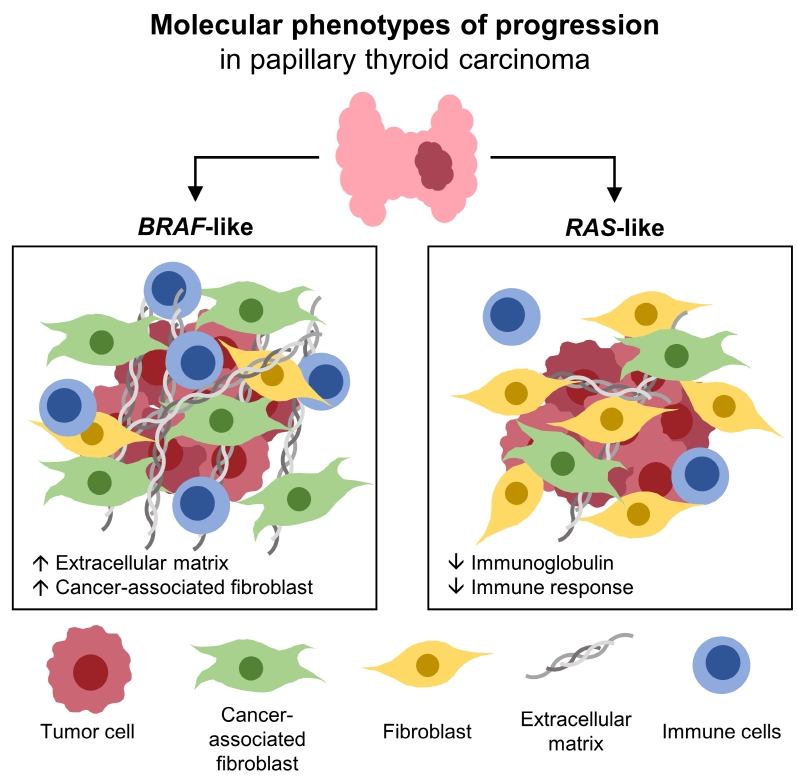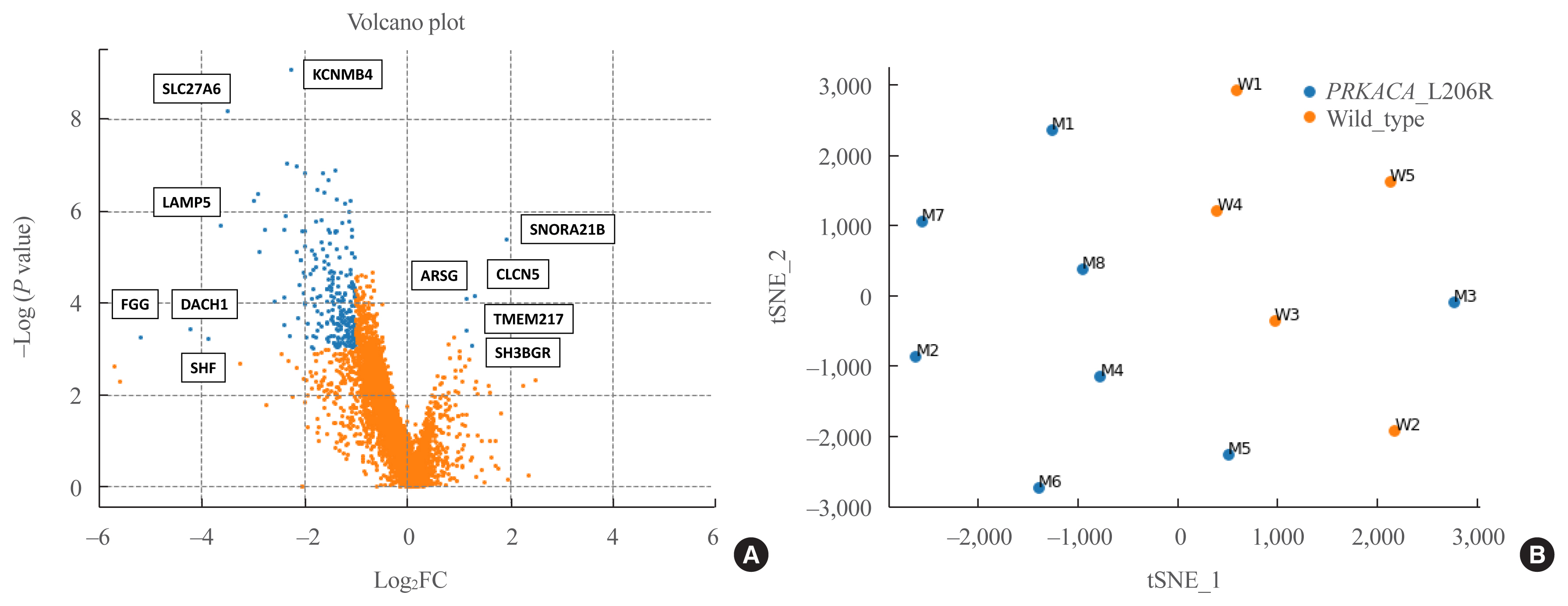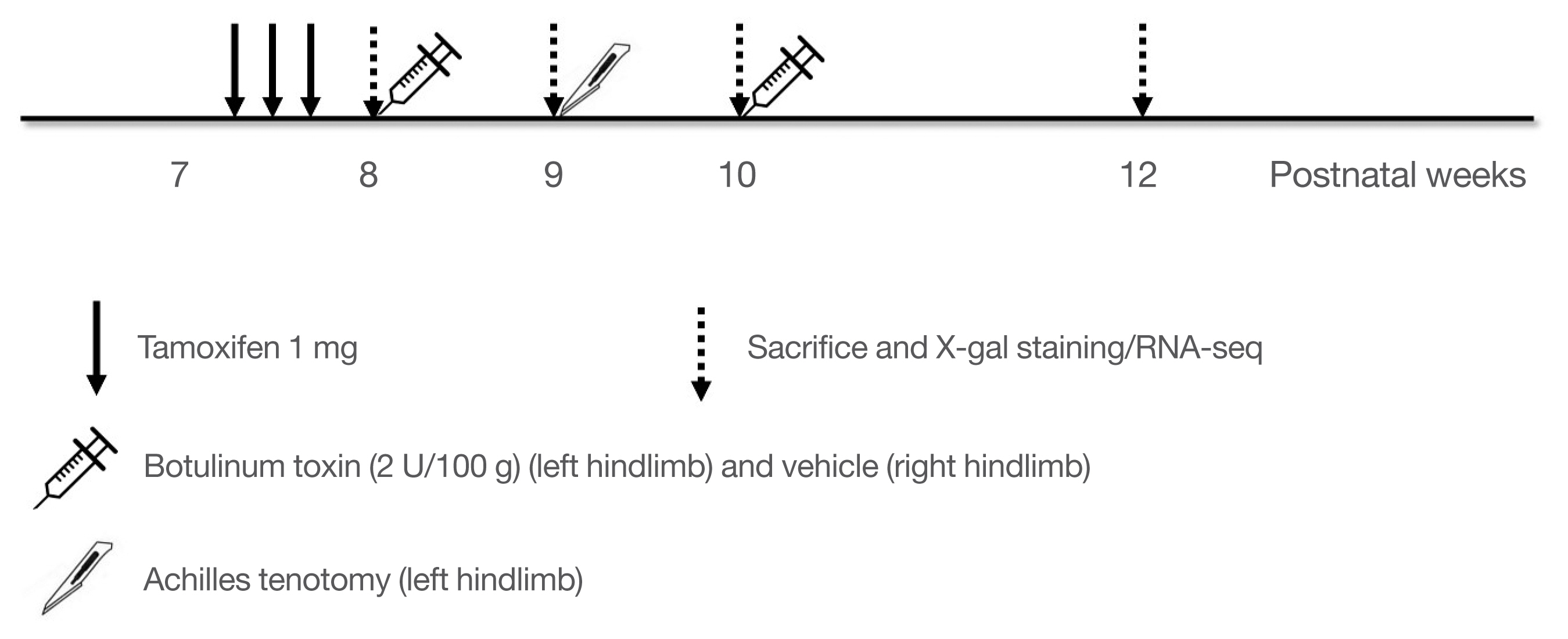Search
- Page Path
- HOME > Search
- Thyroid
- Different Molecular Phenotypes of Progression in BRAF- and RAS-Like Papillary Thyroid Carcinoma
- Jinsun Lim, Han Sai Lee, Jiyun Park, Kyung-Soo Kim, Soo-Kyung Kim, Yong-Wook Cho, Young Shin Song
- Endocrinol Metab. 2023;38(4):445-454. Published online July 18, 2023
- DOI: https://doi.org/10.3803/EnM.2023.1702

- 1,678 View
- 102 Download
-
 Abstract
Abstract
 PDF
PDF Supplementary Material
Supplementary Material PubReader
PubReader  ePub
ePub - Background
Papillary thyroid carcinoma (PTC) can be classified into two distinct molecular subtypes, BRAF-like (BL) and RASlike (RL). However, the molecular characteristics of each subtype according to clinicopathological factors have not yet been determined. We aimed to investigate the gene signatures and tumor microenvironment according to clinicopathological factors, and to identify the mechanism of progression in BL-PTCs and RL-PTCs.
Methods
We analyzed RNA sequencing data and corresponding clinicopathological information of 503 patients with PTC from The Cancer Genome Atlas database. We performed differentially expressed gene (DEG), Gene Ontology, and molecular pathway enrichment analyses according to clinicopathological factors in each molecular subtype. EcoTyper and CIBERSORTx were used to deconvolve the tumor cell types and their surrounding microenvironment.
Results
Even for the same clinicopathological factors, overlapping DEGs between the two molecular subtypes were uncommon, indicating that BL-PTCs and RL-PTCs have different progression mechanisms. Genes related to the extracellular matrix were commonly upregulated in BL-PTCs with aggressive clinicopathological factors, such as old age (≥55 years), presence of extrathyroidal extension, lymph node metastasis, advanced tumor-node-metastasis (TNM) stage, and high metastasis-age-completeness of resection- invasion-size (MACIS) scores (≥6). Furthermore, in the deconvolution analysis of tumor microenvironment, cancer-associated fibroblasts were significantly enriched. In contrast, in RL-PTCs, downregulation of immune response and immunoglobulin-related genes was significantly associated with aggressive characteristics, even after adjusting for thyroiditis status.
Conclusion
The molecular phenotypes of cancer progression differed between BL-PTC and RL-PTC. In particular, extracellular matrix and cancer-associated fibroblasts, which constitute the tumor microenvironment, would play an important role in the progression of BL-PTC that accounts for the majority of advanced PTCs.

- Adrenal Gland
- Clinical and Molecular Characteristics of PRKACA L206R Mutant Cortisol-Producing Adenomas in Korean Patients
- Insoon Jang, Su-jin Kim, Ra-Young Song, Kwangsoo Kim, Seongmin Choi, Jang-Seok Lee, Min-Kyeong Gwon, Moon Woo Seong, Kyu Eun Lee, Jung Hee Kim
- Endocrinol Metab. 2021;36(6):1287-1297. Published online December 2, 2021
- DOI: https://doi.org/10.3803/EnM.2021.1217

- 3,909 View
- 127 Download
-
 Abstract
Abstract
 PDF
PDF Supplementary Material
Supplementary Material PubReader
PubReader  ePub
ePub - Background
An activating mutation (c.617A>C/p.Lys206Arg, L206R) in protein kinase cAMP-activated catalytic subunit alpha (PRKACA) has been reported in 35% to 65% of cases of cortisol-producing adenomas (CPAs). We aimed to compare the clinical characteristics and transcriptome analysis between PRKACA L206R mutants and wild-type CPAs in Korea.
Methods
We included 57 subjects with CPAs who underwent adrenalectomy at Seoul National University Hospital. Sanger sequencing for PRKACA was conducted in 57 CPA tumor tissues. RNA sequencing was performed in 13 fresh-frozen tumor tissues.
Results
The prevalence of the PRKACA L206R mutation was 51% (29/57). The mean age of the study subjects was 42±12 years, and 87.7% (50/57) of the patients were female. Subjects with PRKACA L206R mutant CPAs showed smaller adenoma size (3.3±0.7 cm vs. 3.8±1.2 cm, P=0.059) and lower dehydroepiandrosterone sulfate levels (218±180 ng/mL vs. 1,511±3,307 ng/mL, P=0.001) than those with PRKACA wild-type CPAs. Transcriptome profiling identified 244 differentially expressed genes (DEGs) between PRKACA L206R mutant (n=8) and wild-type CPAs (n=5), including five upregulated and 239 downregulated genes in PRKACA L206R mutant CPAs (|fold change| ≥2, P<0.05). Among the upstream regulators of DEGs, CTNNB1 was the most significant transcription regulator. In several pathway analyses, the Wnt signaling pathway was downregulated and the steroid biosynthesis pathway was upregulated in PRKACA mutants. Protein-protein interaction analysis also showed that PRKACA downregulates Wnt signaling and upregulates steroid biosynthesis.
Conclusion
The PRKACA L206R mutation in CPAs causes high hormonal activity with a limited proliferative capacity, as supported by transcriptome profiling.

- Endocrine Research
- Transformation of Mature Osteoblasts into Bone Lining Cells and RNA Sequencing-Based Transcriptome Profiling of Mouse Bone during Mechanical Unloading
- A Ram Hong, Kwangsoo Kim, Ji Yeon Lee, Jae-Yeon Yang, Jung Hee Kim, Chan Soo Shin, Sang Wan Kim
- Endocrinol Metab. 2020;35(2):456-469. Published online June 24, 2020
- DOI: https://doi.org/10.3803/EnM.2020.35.2.456
- Correction in: Endocrinol Metab 2021;36(6):1314

- 7,645 View
- 172 Download
- 10 Web of Science
- 10 Crossref
-
 Abstract
Abstract
 PDF
PDF Supplementary Material
Supplementary Material PubReader
PubReader  ePub
ePub - Background
We investigated RNA sequencing-based transcriptome profiling and the transformation of mature osteoblasts into bone lining cells (BLCs) through a lineage tracing study to better understand the effect of mechanical unloading on bone loss.
Methods
Dmp1-CreERt2(+):Rosa26R mice were injected with 1 mg of 4-hydroxy-tamoxifen three times a week starting at postnatal week 7, and subjected to a combination of botulinum toxin injection with left hindlimb tenotomy starting at postnatal week 8 to 10. The animals were euthanized at postnatal weeks 8, 9, 10, and 12. We quantified the number and thickness of X-gal(+) cells on the periosteum of the right and left femoral bones at each time point.
Results
Two weeks after unloading, a significant decrease in the number and a subtle change in the thickness of X-gal(+) cells were observed in the left hindlimbs compared with the right hindlimbs. At 4 weeks after unloading, the decrease in the thickness was accelerated in the left hindlimbs, although the number of labeled cells was comparable. RNA sequencing analysis showed downregulation of 315 genes in the left hindlimbs at 2 and 4 weeks after unloading. Of these, Xirp2, AMPD1, Mettl11b, NEXN, CYP2E1, Bche, Ppp1r3c, Tceal7, and Gadl1 were upregulated during osteoblastogenic/osteocytic and myogenic differentiation in vitro.
Conclusion
These findings demonstrate that mechanical unloading can accelerate the transformation of mature osteoblasts into BLCs in the early stages of bone loss in vivo. Furthermore, some of the genes involved in this process may have a pleiotropic effect on both bone and muscle. -
Citations
Citations to this article as recorded by- Insights and implications of sexual dimorphism in osteoporosis
Yuan-Yuan Zhang, Na Xie, Xiao-Dong Sun, Edouard C. Nice, Yih-Cherng Liou, Canhua Huang, Huili Zhu, Zhisen Shen
Bone Research.2024;[Epub] CrossRef - METTLing in Stem Cell and Cancer Biology
John G. Tooley, James P. Catlin, Christine E. Schaner Tooley
Stem Cell Reviews and Reports.2023; 19(1): 76. CrossRef - Three's a crowd – why did three N-terminal methyltransferases evolve for one job?
Meghan M. Conner, Christine E. Schaner Tooley
Journal of Cell Science.2023;[Epub] CrossRef - Unlocking the mysteries of alpha-N-terminal methylation and its diverse regulatory functions
Panyue Chen, Rong Huang, Tony R. Hazbun
Journal of Biological Chemistry.2023; 299(7): 104843. CrossRef - Examining Mechanisms for Voltage-Sensitive Calcium Channel-Mediated Secretion Events in Bone Cells
Perla C. Reyes Fernandez, Christian S. Wright, Mary C. Farach-Carson, William R. Thompson
Calcified Tissue International.2023; 113(1): 126. CrossRef - Reactivation of Bone Lining Cells are Attenuated Over Repeated Anti-sclerostin Antibody Administration
A Ram Hong, Jae-Yeon Yang, Ji Yeon Lee, Joonho Suh, Yun-Sil Lee, Jung-Eun Kim, Sang Wan Kim
Calcified Tissue International.2022; 111(5): 495. CrossRef - Purine metabolism in the development of osteoporosis
Keda Yang, Jie Li, Lin Tao
Biomedicine & Pharmacotherapy.2022; 155: 113784. CrossRef - Effects of Gabapentin and Pregabalin on Calcium Homeostasis: Implications for Physical Rehabilitation of Musculoskeletal Tissues
Perla C. Reyes Fernandez, Christian S. Wright, Stuart J. Warden, Julia Hum, Mary C. Farach-Carson, William R. Thompson
Current Osteoporosis Reports.2022; 20(6): 365. CrossRef - Calvaria Bone Transcriptome in Mouse Models of Osteogenesis Imperfecta
Pierre Moffatt, Iris Boraschi-Diaz, Juliana Marulanda, Ghalib Bardai, Frank Rauch
International Journal of Molecular Sciences.2021; 22(10): 5290. CrossRef - Age-related neurodegeneration and cognitive impairments of NRMT1 knockout mice are preceded by misregulation of RB and abnormal neural stem cell development
James P. Catlin, Leandro N. Marziali, Benjamin Rein, Zhen Yan, M. Laura Feltri, Christine E. Schaner Tooley
Cell Death & Disease.2021;[Epub] CrossRef
- Insights and implications of sexual dimorphism in osteoporosis

- Endocrine Research
- Transcriptome Analysis Identifies an Attenuated Local Immune Response in Invasive Nonfunctioning Pituitary Adenomas
- Yong Hwy Kim, Jung Hee Kim
- Endocrinol Metab. 2019;34(3):314-322. Published online September 26, 2019
- DOI: https://doi.org/10.3803/EnM.2019.34.3.314
- Correction in: Endocrinol Metab 2020;35(4):965
- 5,290 View
- 58 Download
- 12 Web of Science
- 12 Crossref
-
 Abstract
Abstract
 PDF
PDF Supplementary Material
Supplementary Material PubReader
PubReader  ePub
ePub Background Invasive nonfunctioning pituitary adenomas (NFPAs) remain challenging due to their high complication rate and poor prognosis. We aimed to identify the distinctive molecular signatures of invasive NFPAs, compared with noninvasive NFPAs, using gene expression profiling by RNA sequencing.
Methods We obtained frozen fresh tissue samples from 14 patients with NFPAs who underwent primary transsphenoidal surgery. Three non-invasive and 11 invasive NFPAs were used for RNA sequencing. The bioinformatics analysis included differential gene expression, gene ontology analysis, and pathway analysis.
Results A total of 700 genes were differentially expressed (59 up-regulated and 641 down-regulated genes) between invasive and non-invasive NFPAs (false discovery rate <0.1, and |fold change| ≥2). Using the down-regulated genes in invasive NFPAs, gene ontology enrichment analyses and pathway analyses demonstrated that the local immune response was attenuated and that transforming growth factor-β (TGF-β) RII-initiated TGF-β signaling was down-regulated in invasive NFPAs. The overexpression of claudin-9 (
CLDN9 ) and the down-regulation of insulin-like growth factor-binding protein 5 (IGFBP5 ), death-associated protein kinase 1 (DAPK1 ), and tissue inhibitor of metalloproteinase-3 (TIMP3 ) may be related with invasiveness in NFPAs.Conclusion Invasive NFPAs harbor different gene expression profiles relative to noninvasive NFPAs. In particular, local suppression of the immune response and TGF-β signaling can make PAs prone to invasiveness.
-
Citations
Citations to this article as recorded by- Research status and prospects of pituitary adenomas in conjunction with neurological and psychiatric disorders and the tumor microenvironment
Siyuan Cui, Sainan Chen, Xuechao Wu, Qing Wang
Frontiers in Neuroscience.2024;[Epub] CrossRef - Immune landscape and progress in immunotherapy for pituitary neuroendocrine tumors
Xiaopeng Guo, Yiying Yang, Zhihong Qian, Mengqi Chang, Yuanli Zhao, Wenbin Ma, Yu Wang, Bing Xing
Cancer Letters.2024; : 216908. CrossRef - Transcriptome of GH-producing pituitary neuroendocrine tumours and models are significantly affected by somatostatin analogues
Rihards Saksis, Olesja Rogoza, Helvijs Niedra, Kaspars Megnis, Ilona Mandrika, Inga Balcere, Liva Steina, Janis Stukens, Austra Breiksa, Jurijs Nazarovs, Jelizaveta Sokolovska, Ilze Konrade, Raitis Peculis, Vita Rovite
Cancer Cell International.2023;[Epub] CrossRef - PD-L1 Expression in Pituitary Neuroendocrine Tumors/Pituitary Adenomas
Giulia Cossu, Stefano La Rosa, Jean Philippe Brouland, Nelly Pitteloud, Ethan Harel, Federico Santoni, Maxime Brunner, Roy Thomas Daniel, Mahmoud Messerer
Cancers.2023; 15(18): 4471. CrossRef - Aggressive PitNETs and Potential Target Therapies: A Systematic Review of Molecular and Genetic Pathways
Simona Serioli, Ludovico Agostini, Alberto Pietrantoni, Federico Valeri, Flavia Costanza, Sabrina Chiloiro, Barbara Buffoli, Amedeo Piazza, Pietro Luigi Poliani, Maria Peris-Celda, Federica Iavarone, Simona Gaudino, Marco Gessi, Giovanni Schinzari, Pier P
International Journal of Molecular Sciences.2023; 24(21): 15719. CrossRef - Muti-omics integration analysis revealed molecular network alterations in human nonfunctional pituitary neuroendocrine tumors in the framework of 3P medicine
Siqi Wen, Chunling Li, Xianquan Zhan
EPMA Journal.2022; 13(1): 9. CrossRef - A systematic review of molecular alterations in invasive non-functioning pituitary adenoma
Nazanin Hosseinkhan, Maryam Honardoost, Zahra Emami, Sara Cheraghi, Nahid Hashemi-Madani, Mohammad E. Khamseh
Endocrine.2022; 77(3): 500. CrossRef - Medication for Acromegaly Reduces Expression of MUC16, MACC1 and GRHL2 in Pituitary Neuroendocrine Tumour Tissue
Rihards Saksis, Ivars Silamikelis, Pola Laksa, Kaspars Megnis, Raitis Peculis, Ilona Mandrika, Olesja Rogoza, Ramona Petrovska, Inga Balcere, Ilze Konrade, Liva Steina, Janis Stukens, Austra Breiksa, Jurijs Nazarovs, Jelizaveta Sokolovska, Valdis Pirags,
Frontiers in Oncology.2021;[Epub] CrossRef - Large Scale Molecular Studies of Pituitary Neuroendocrine Tumors: Novel Markers, Mechanisms and Translational Perspectives
Raitis Peculis, Helvijs Niedra, Vita Rovite
Cancers.2021; 13(6): 1395. CrossRef - Nkx3-1 and Fech genes might be switch genes involved in pituitary non-functioning adenoma invasiveness
Nasibeh Khayer, Maryam Jalessi, Amin Jahanbakhshi, Alireza Tabib khooei, Mehdi Mirzaie
Scientific Reports.2021;[Epub] CrossRef - The tumour microenvironment of pituitary neuroendocrine tumours
Pedro Marques, Ashley B. Grossman, Márta Korbonits
Frontiers in Neuroendocrinology.2020; 58: 100852. CrossRef - The Progress of Immunotherapy in Refractory Pituitary Adenomas and Pituitary Carcinomas
Congxin Dai, Siyu Liang, Bowen Sun, Jun Kang
Frontiers in Endocrinology.2020;[Epub] CrossRef
- Research status and prospects of pituitary adenomas in conjunction with neurological and psychiatric disorders and the tumor microenvironment


 KES
KES

 First
First Prev
Prev



